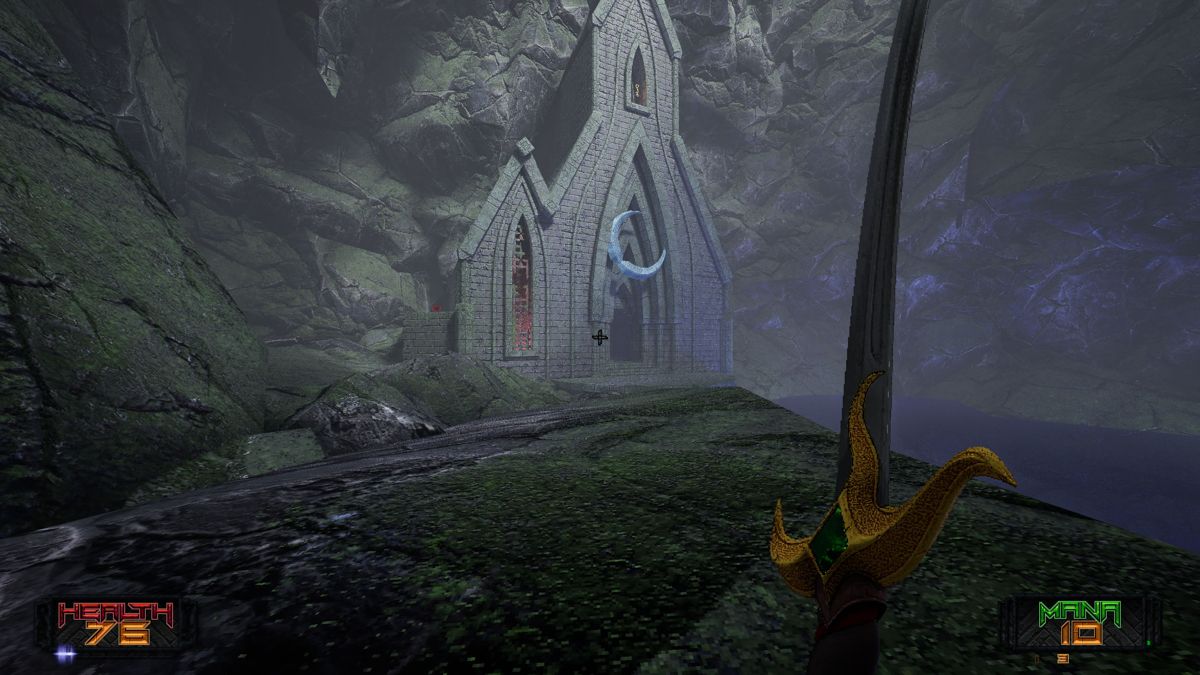A happy effect of the rise of digital distribution and the return of a sort of video game midlist is that it made genres that had been decreed dead and buried by blockbuster-minded publishers viable again. Turn-based RPGs, 8- and 16-bit-style pixel art games, point-and-click adventures...and mid-90s-style FPSs that prioritize labyrinthine level design and pure frenetic gameplay over linear cinematic experiences. Amid Evil is among the leaders of a retro FPS movement that also includes games such as Dusk and Ion Fury. It's the product of Indefatigable, a studio formed by two guys that previously contributed to the 2013 remake of Rise of the Triad, and it takes heavily after Quake and the Heretic/Hexen series.
There is a story underpinning the game, but it's so basic that it would almost be better if it wasn't included at all. The player controls the Champion, who claimed the axe of the Black Labyrinth that allows him to travel among dimensions. The Champion is directed by a pantheon of fallen gods to exterminate the "Evil Force" that is corrupting reality. And mercifully that's about it. The Champion begins in a hub world and travels to several different worlds, arriving with only his axe to begin but accumulating six other magical weapons with which to cleanse the worlds before challenging the Evil Force in a final Lovecraftian dimension. So it takes after the more cosmic, dimension-hopping side of the genre, as in Moorcock's Eternal Champion works, or perhaps Zelazny's Amber books or Adrian Cole's Voidal stories, among others.
As with the classic games it emulates, the only things to worry about are slaughtering everything in your path and finding keys that unlock doors. Despite the comparisons to Heretic, it lacks the inventory management aspects of that game, and the barebones style and 3D visuals better evoke Quake. On the other hand, it's much more colorful than Quake's notorious brown and grey aesthetic.
The weapons generally fall into the traditional FPS pattern but each has a particular twist. The first ranged weapon acquired is a water magic staff that spews homing projectiles at enemies. The "shotgun" is a jeweled sword that when swung sends out a broad green wave that can hit multiple enemies at once. The "rocket launcher", known as the Celestial Claw, is a gnarled staff that literally yanks planets out of orbit and hurls them at enemies. Killing enemies causes them to drop their souls, and when the player collects enough, the player can temporarily activate a more powerful, alternate fire mode for each weapon; e.g., the Celestial Claw now grabs stars instead of planets.
FPSs in this style are often looked down upon because of their simplicity, but there are arguments that the first person perspective and their terse presentation can be more evocative than games that work harder at conjuring an atmosphere. Many RPGs, for instance, include reams of text and even extensive, fully voiced dialogue among massive casts of characters in trying to develop their settings. Some succeed more than others, but the vast majority can't overcome a tedious flatness. Amid Evil has almost no dialogue or story and yet probably succeeds better than most more complicated games in providing a sense of a desperate struggle in strange lands that sprawl vertically as much as horizontally. Some of the worlds, such as the worlds of the moon or sun worshippers are merely beautiful to look at, with clear skies above high towers that might not be too out of place in the real world. Others get weird with colossal structures that serve no discernible purpose but which need traversal regardless. The Forges are a world of constantly chugging machines of giant gears and levers, occupied by living machine creatures. The final level, the Void, is as aggressively Lovecraftian in its depiction of non-Euclidean geometry as a game can reasonably get while still remaining navigable. Some parts can be genuinely unnerving to look at, never mind the strange creatures constantly attacking.
Speaking of the creatures, each world has its own unique set. The game's sound design is top level and once you know what to listen for, you can reliably tell when a monster has been roused (and if you hear it, you know it's coming for you at top speed), when you've scored a hit, and when you've defeated it. The graphics are beautiful in their odd combination of looking fine at a distance but revealing chunky pixellation up close.








No comments:
Post a Comment